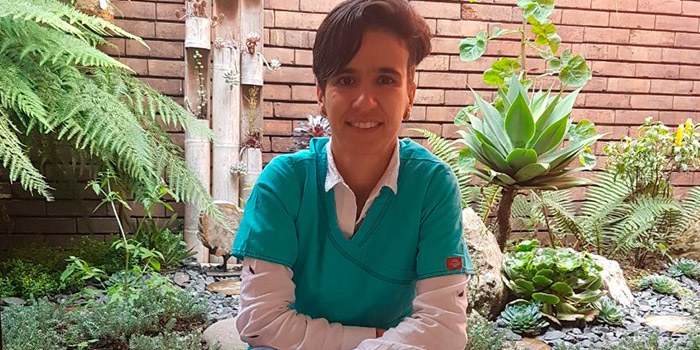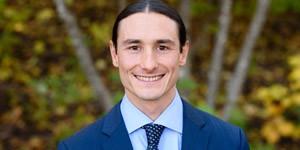By Sarah Russo

Sarah Russo is a writer, cannabis consultant, and a social media and content manager. She got her degree in environmental studies and social justice, with a focus in plant medicine from the Evergreen State College. She has previously worked for Project CBD and the Society of Cannabis Clinicians. She has also acted as an herbal medicine educator in natural remedy apothecary shops. Some of her main goals are diversifying the cannabis movement by integrating the plant into the greater herbal medicine compendium as well as encouraging sustainable agricultural practices.
Meet the Experts is a series of interviews conducted by experts from the field of Cannabis to world leaders in research and clinical practice of Cannabis as medicine.
Degree in Medicine and Surgery from the Pontifical Bolivarian University. Specialist Degree in Medical Law from the same university. Master's Degree in HIV from the Rey Juan Carlos University of Madrid. Member of the Curativa medicinal cannabis research group.

Some years ago, faced with a patient who was not responding to conventional treatment, Dr Pineda set out to find new alternatives for pain management. It was then that she first started using cannabis for therapeutic purposes. She later took part in the first discussions on the subject in the Colombian Congress, where she met mothers of children with refractory epilepsy who were seeking medical advice on treatment for their children. Although she began working on the subject in her spare time, she now devotes all of her professional life to it. She has been involved in the treatment of over 1800 people looking to cannabis as a therapeutic tool.
Sarah Russo: Could you tell us a bit about the situation in Colombia when you began prescribing cannabis in your practice?
Paola Pineda: I first prescribed cannabis to a chronic HIV patient. Although the infection was well under control, he had problems with insomnia and chronic pain, which were not responding to traditional drugs. We began studying the matter and found that we could achieve positive results with cannabis. On his third day of cannabis use, he reported that for the first time in many years his pain was more manageable and his sleep more restorative. At the time, I had only some very basic notions of the subject and we began to explore how we could safely obtain cannabis in Colombia.
The first thing I discovered was that there were cannabis growers with extensive experience who had been successfully helping large numbers of patients, though without any medical accompaniment. I therefore decided it was very important that we should work with them. The idea was to bring some scientific rigor to the issue and we began working together. From them, I learnt that under an unregulated act dating back to 1986, cannabis was permitted for medicinal uses. I consulted a lawyer specialising in criminal law. He explained the nature of the law and told me that under this act and the Medical Ethics Act, we could prescribe cannabis to anyone who needed it.
That was when I first started prescribing cannabis. Initially, the situation was more complex; drug trafficking, prohibitionist policies and the war on drugs have caused great harm in our country. Moreover, the endocannabinoid system was not included on the syllabus of our medical schools. That meant that we only learnt about cannabis in subjects such as toxicology and psychiatry, with no discussion of its therapeutic value. In that context, discussing cannabis for medicinal purposes posed a number of personal and professional challenges. However, over time, increasing numbers of doctors began to join us with an interest in offering therapeutic tools that could meet the needs of patients. We continued working with the growers, processors and academics from the basic sciences. We also held discussions with committed public authorities, including the Minister of Health, Alejandro Gaviria, who has been a key figure in this whole process. That said, the people who were most important people in moving the process forward were the patients and their families. As in other parts of the world, the great protagonists of this story have been the mothers of epilepsy patients. As a result of the combined strength of all these people, Colombia now has some of the most inclusive regulation anywhere in Latin America.
SR: What is going on in the field of cannabis in Colombia that makes it different to other parts of the world?
PP: Our recent past has been marked by the great pain caused by drug trafficking and the war on drugs. With regulation, Colombia has a historic opportunity to make up for so much harm. We can be a more inclusive country. People who worked illegally —not by choice, but because they had no other option— can now rejoin the workforce, put their work to good use and contribute to this project legally and transparently. We are in a post-conflict period. If we organise ourselves properly, we can turn medicinal cannabis into a source of development.
In the past, Colombia was one of the largest exporters of illicit drugs. Why should we not now become a global power, exporting research and expertise? We have an exceptionally favourable geography, allowing crops to be grown all year round in different territories. We can make very high quality and effective products that will be affordable for the people who need them.
It is important to bear in mind that a large area of the Colombian countryside was fumigated during the war on drugs. The toxins used in those procedures remain in the soil for a long time. As a result, in some places agricultural processes will be required to make the land suitable for cultivating a plant with great medicinal potential. That does not mean that we do not currently have anywhere to grow cannabis. There is already land which is suitable for the process. However, as demand increases, anyone interested in getting involved will have to take the soil quality into account.
Fortunately the regulations allow large and small growers to participate within a legal framework. At the same time, the clinical experience in Colombia is also important. We can continue learning and improving our teamwork. We can work with researchers from other parts of the world, partnering up with them to create new collaborative research strength.
SR: What has your experience as a woman in the cannabis movement been like?
PP: It is much easier now for women to work in different areas of knowledge than it used to be. Thanks to the commitment of some great women throughout history and their fight for equality, things have changed. It is interesting to see how many leading global figures in this area are women — not only in the scientific field, but also in the area of activism. It is no secret that the cause of medicinal cannabis has been largely promoted by mothers of children with epilepsy and other neurological conditions in Chile, Argentina, Peru, Colombia, the US and Mexico. There are still vestiges of gender inequality and sexism in many parts of the world, meaning that women face a greater challenge. Symbolically, it is significant that the plant that provides the medicine is the female.
SR: What do you think of legislation that permits CBD but bans THC?
PP: These laws ignore the findings of major scholars from around the world. In cannabis, the entourage effect is important; all the molecules in the plant act in combination to give better results from a medicinal perspective. Among other components, cannabinoids, flavonoids and terpenes have great therapeutic potential when they operate together, but not when they function individually. The plant is a perfect creation of nature. Many people insist that cannabis-based drugs should be produced from a single composite of the plant, even though numerous studies have shown that they are not as effective.
My own personal opinion is that the legislation that allows only CBD to be used is rooted in commercial interests. People who see cannabis merely as a cash crop will continue to argue that CBD is the only medicinal composite. I am optimistic, however, and more and more people are coming to see that for the best results it is necessary to use extracts from the whole plant.
SR: Do you have an initial dose for people who are beginning to use cannabis, or does it depend on the person?
PP: Cannabis-based medicine has to be personalised. Each individual is a world onto themselves. It is essential to have a comprehensive initial clinical assessment, taking into account the patient's complete history, comorbidity, the drugs they are using, their expectations and their perception of the plant. This is also a good moment to educate them, to answer any queries they may have and to explode some of the myths on cannabis use. We usually begin with low doses and gradually increase them in line with the therapeutic target. We assess the patients' responses on a case-by-case basis. When using drugs with only one active molecule, you normally adjust the dose according to the patient's weight, age, sex and comorbidity. With cannabis, however, the approach is different. This is why medical accompaniment is essential, in order to identify the dose that best suits their needs and their clinical condition.
SR: What considerations need to be taken with patients who are taking prescription drugs when they are going to use cannabis?
PP: This is a very important issue. We should never forget that there are pharmacological interactions. For example, some studies suggest that when extracts with a high CBD content are used, the dose of antiepileptic drugs such as clobazam needs to be adjusted. Cannabinoids cause vasodilation, reducing blood pressure, so in the case of patients with controlled hypertension, their medication levels needs to be adjusted. Cannabinoids can reinforce the action of opiates, making it possible to reduce the dose and reduce some of the side effects. For all of these reasons, each patient has to be assessed thoroughly.
Few doctors anywhere in the world are currently trained to use cannabis for medicinal purposes. Even though the endocannabinoid system has now been described for a number of years, very few health science faculties include it on their syllabuses. It takes dedication and a personal interest to educate yourself in the subject. Teamwork between growers, processors, researchers in preclinical areas, clinicians and patients will help achieve better results. We should take the entourage effect I mentioned as our example and apply it to our work.
SR: Do you have any particularly striking story you can share with us of a patient using cannabis for medicinal purposes? Are there people for whom cannabis does not work?
PP: In reality, all my patients teach me something. No substance is effective for 100% of people. It would be unrealistic to expect them to work the same for everyone. The response has been particularly striking in cases where patients had given up all hope, where the internationally approved drugs were not proving effective. All our patients should give us the motivation to keep on investigating.
Many people think that the effect is going to be immediate, that they will be able to suspend treatment with the other drugs they were using before cannabis. As a result, they sometimes throw in the towel if they don't see a response in the first week. It is important to explain all this to patients and their support networks. You need to remind them that there are many active ingredients and there isn't a single extract for everyone. You can make changes, using different extracts for the same patient. This is what I have learnt from my ongoing work with users. It is essential to work closely with the growers, processors and chemists to optimise the options. As with any substance, we also have cases where despite making a number of changes, and increasing the dose, we have not managed to achieve the desired response. At the beginning of any treatment, it is important to look at the patient's habits. We cannot expect miracles from a single drop. It is important to make basic changes in things like food, physical activity, sleep, stress management, substance abuse and the use of mobile devices.
SR: Thank you, Paola, for your time and attention.


